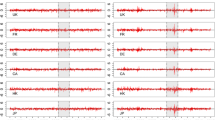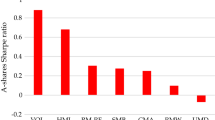Abstract
Using daily data we show sudden, extreme declines in the U.S. stock market for crash dates to lead to a capital preserving (as opposed to strategic or tactical) reallocation to government debt securities. In most cases we find flight-induced reallocation reverses direction within one day of a crash. However, for the 1987 world crash we find increased and persistent return volatility in both equity and bond returns lasting up to five days following this dramatic decline in world equity prices. Like previous research in this area, we find equity crashes alter long-run stock/bond return correlations and lead to increased stock and bond return volatility. Finally, we describe the somewhat unique stock and bond correlation adjustments triggered by the 9/11 attack and the impact this event had on the behavior of U.S. equity investors’ flight-to-safety reaction.
Similar content being viewed by others
Notes
Prior to regression estimation using these pre-identified event dates we apply the Inclan-Tsiao (1994) variance change point method to the stock and bond return time series over the 1984–2006 period. This cumulative sum-of-squares method is based upon an iterative two-step approach where potential return breakpoints are first identified and then confirmed. We therefore let the data in conjunction with the Inclan-Tiao algorithm determine the crash dates prior to using them in the regression model. See Smith and Brocato (2010) and Smith and Bracker (2003) for applications of the Inclan-Tsiao technique.
Neither U.S. corporate grade debt nor foreign government sovereign debt are included in the model estimated in this paper. Informal statistical tests suggest that these alternative assets do not provide a temporary safe haven for equity investors during the crashes studied. These tests are available from the authors upon request.
Since Table 2 only reports data for days t and t + 1 it omits three equity decline dates in what was a reverberating sequence of crashes in October 1987. On Friday October 16, the S&P 500 index declined by 5.29 percent, while the U.S. government bond market index increased by 0.11 percent. On Monday, October 26, U.S. equities declined by 8.64 percent, while government bonds increased by 1.58 percent (see Table 3 for supporting regression evidence). Finally, on Tuesday, October 27 U.S. equities increased by 2.39 percent while bonds decreased by 1.19 percent. Checking the daily data through Monday November 2, we find no other significant positive or negative percentage changes in either the stock or bond indexes.
While other methodologies are available in the empirical finance literature to test for time-varying correlations (e.g., ARCH, DCC, copulas, Markow switching, etc.), we choose the Dufour dummy variable technique because the estimated intercept shift estimates allow for straightforward economic and statistical interpretation of investor crash response we are interested in.
The model is estimated without slope dummies. Tests for changes in the slope coefficient using dummy variables produced statistically insignificant results.
We point out that the previously-cited Inclan-Tsiao procedure does identify a shift breakpoint with a statistically significant increase in the variance of equity returns on this date.
References
Brocato J, Steed S (1998) Optimal asset allocation over the business cycle. Financ Rev 33:129–148
Campbell R, Koedijk K, Kofman P (2002) Increased correlation in bear markets. Financ Anal J 58:87–94
Chowdhury M, Lin J (1993) Fads and the crash of ‘87. Financ Rev 28:385–401
Dopfel F (2003) Asset allocation in a lower stock-bond correlation environment. J Portf Manage 25–28
Dufour J (1980) Dummy variables and predictive tests for structural change. Econom Lett 6:241–247
Dungey M, Fry R, Gonzalez-Hermosillo B, Martin V (2006) Contagion in international bond markets during the Russian and the LTCM crises. J Financ Stab 2:1–27
Engle R (2002) Dynamic conditional correlation: a simple class of multivariate generalized autoregressive conditional heteroskedasticity models. J Bus Econ Stat 20:339–350
Guidolin M, Timmermann A (2005) Economic implications of bull and bear regimes in UK stock and bond returns. Econ J 115:111–143
Gulko L (2002) Decoupling. J Portf Manage 59–66
Hamao Y, Masulis R, Ng V (1990) Correlation in price changes and volatility across international stock markets. Rev Financ Stud 3:281–307
Hays W, Winkler R (1971) Statistics: probability, inference, and decision. Holt, Rinehart & Winston, New York, p 653
Ilmanen A (2003) Stock-bond correlations. J Fixed Income 55–66
Inclan C, Tsiao G (1994) Use of cumulative sum of squares for retrospective detections of changing variance. J Am Stat Assoc 89:913–923
Kamphuis R, et al. (ed) (1988) Black Monday and the future of financial markets. Dow Jones-Irwin Inc
Mun C (2005) Contagion and impulse response of international stock markets around the 9–11 terrorist attacks. Glob Financ J 16:48–68
Moreno R, Pasadilla G, Remolona E (1998) Asia’s financial crisis: lessons and policy responses. In: Asia: responding to crisis. Asian Development Bank Institute
Morningstar, Inc (2007) SBBI Yearbook
Nikkinen J, Omran M, Sahlstrom P, Aifo J (2008) Stock returns and volatility following the September 11 attacks: evidence from 53 equity markets. Int Rev Financ Analy 17:27–46
Poterba J, Summers M (1998) Mean reversion in stock prices: evidence and implications. J Financ Econ 27–59
Roll R (1988) The international crash of October 1987. In: Kamphuis R et al. (ed) Black Monday and the future of financial markets. Dow Jones Irwin Inc
Sacks J, Radelet S (1998) The onset of the east Asian financial crisis. In: Harvard Institute for International Development (working paper)
Saha A, Malkiel B, Grecu A (2009) The clustering of extreme movements: stock prices and the weather. J Invest Manag 7:115–122
Schwert G (1989) Why does stock market volatility change over time? J Financ 44:1115–1153
Schwert G (1990) Stock volatility and the crash of ‘87. Rev Financ Stud 3:77–102
Scruggs J, Glabadanidis P (2003) Risk premia and the dynamic covariance between stock and bond returns. J Financ Quant Anal 38:295–316
Smith KL, Bracker K (2003) Forecasting changes in copper futures volatility with GARCH models using an iterative algorithm. Rev Quant Financ Account 20:245–265
Smith KL, Brocato J (2010) Applying the Inclan-Tsiao breakpoint algorithm in the search for the flight-to-safety phenomenon. Appl Financ Econ 20(5):371–380
Solnik B, Boucrelle C, LeFur Y (1996) International market correlation and volatility. Financ Anal J 17–34
Telser L (1988) October 1987 and the structures of financial markets: An exorcism of demons. In: Kamphuis R, et al. Black Monday and the future of financial markets. Dow Jones-Irwin Inc
Author information
Authors and Affiliations
Corresponding author
Rights and permissions
About this article
Cite this article
Brocato, J., Smith, K.L. Sudden equity price declines and the flight-to-safety phenomenon: additional evidence using daily data. J Econ Finan 36, 712–727 (2012). https://doi.org/10.1007/s12197-010-9147-6
Published:
Issue Date:
DOI: https://doi.org/10.1007/s12197-010-9147-6




